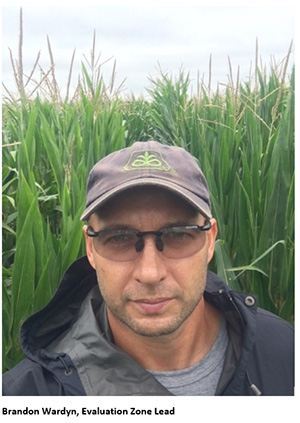Reduced Stature Corn is a Big Deal

The excitement of “what’s old is new again” is evident when plant breeders, researchers, agronomists and farmers talk about the possibilities reduced stature corn may bring. The hybrids may be new, but the process of shortening plant stature is not. Reduced stature allows the stalks to be stronger and more plants can be packed in per acre without the risk of becoming unharvestable. This type of production system was developed with wheat genetics by world-renowned agronomist, Norman Borlaug, in the mid-1950s. That successful work was later duplicated with rice, dramatically increasing yields in both crops.
Though this concept has been viable since Borlaug and his teams completed their work, it has not yet gained broad application in corn hybrids. This doesn’t mean research has been lacking. Far from it.
Cory Christensen is the Pipeline Development Leader for Corn at Corteva Agriscience. His job is to shape new product concepts in the corn pipeline from ideation or inception, and shepherd them through each stage of the development process until they’re ready to launch.
 “Reduced stature corn is not a new idea, but interest in it has quickly picked up steam,” Christensen says. “Over the past 10 years, we have carefully analyzed about 20 different genetic approaches to make corn plants shorter, and our researchers have identified one of those trait approaches that had the characteristics we desired.
“Reduced stature corn is not a new idea, but interest in it has quickly picked up steam,” Christensen says. “Over the past 10 years, we have carefully analyzed about 20 different genetic approaches to make corn plants shorter, and our researchers have identified one of those trait approaches that had the characteristics we desired.
“We were gaining confidence in this trait at the same time the big wind events hit the Midwest in 2020 and 2021. Since we have a native allele version of the trait, we are well-positioned to develop and launch a set of hybrid products to introduce the concept to the market. Hybrids demonstrated excellent resilience under high winds with our trait, and we are confident that growers will realize that benefit among others.”
Christensen is quick to point out other advantages of reduced stature corn include easier ground access for equipment to apply fertilizers and other inputs. There’s also the potential to plant at higher density and increase the per acre yield potential. Specific management recommendations are in development.
The initial hybrid products containing the reduced stature trait are under evaluation and will be on the market in the middle of this decade.
“Our goal is to give growers opportunities to experience these products and see if they perform like we expect they will,” Christensen says. “Most importantly, they must deliver value on customers’ operations just as any hybrid we release does.
“It’s important to understand we are following our normal product development process,” he adds. “We’re approaching this just like we do with other hybrids. We’ve taken some of our new, pre-commercial inbreds, the parents of future hybrid seed products, and converted them to reduced stature inbreds with our trait. These new potential hybrid products are working their way through our product characterization trials.”
Product characterization trials will take place throughout corn-growing regions for at least two years before any new hybrid is launched. Product development teams want to observe genetic and environmental interactions so there is solid confidence in recommendations to growers. In addition, they’re evaluating performance at various densities and will have sound recommendations about planting densities upon launch.
Corteva researchers must address how to define the reduced stature corn concept, understand its genetics, ensure data is correct and how to characterize the product and launch. They must also consider what the genetics and long-term plant breeding program looks like.
“When you think of all the mechanical advances, chemical advances and technological advances, I look at reduced stature corn as another piece of technology that happens to be genetic technology,” Brandon Wardyn, Evaluation Zone Lead, Corteva Agriscience, says.
“It changes some physics of the plant, so this changes how we need to breed for different traits, namely traits associated with tolerating wind. Given this new level of standability, it can really open up the genetic space we can operate in. A basic principle in plant breeding is as you take pressure off one trait, you can apply it to a different trait.”
Looking at the history of corn breeding, researchers were able to get plants to “silk and shed pollen” in relative synchrony. This was a bigger issue 30 years ago than it is now, as breeding has solved it. Today, breeders will be doing similar things with reduced stature corn.
 “Reduced stature corn is going to open what I call the ‘agronomic playbook,’” Wardyn says. “It is going to allow us to go back and reevaluate some basic agronomic principles and let us look at how we can change them to get higher yields.”
“Reduced stature corn is going to open what I call the ‘agronomic playbook,’” Wardyn says. “It is going to allow us to go back and reevaluate some basic agronomic principles and let us look at how we can change them to get higher yields.”
“The rate the industry and growers are successful at this will determine if or how fast reduced stature corn becomes the norm. The potential is there, but there are still a lot of ifs to consider.”
There is considerable acreage of reduced stature corn in testing and it’s growing.
“I’m proud of the process we have,” Wardyn says. “Yes, we want to deliver reduced stature corn, but the overriding principle is that it has to be right for our customers. We can’t put any customer at risk and we’re not going to do that. When we launch a product, we’ll do it in a way that makes a customer profitable and successful. Plus, we’ll promote it by sharing its strengths and weaknesses. This line of thinking is a purposeful part of every meeting we have across all team members.”
He notes that reduced stature corn will not require a significant “change of iron” by any customer, nor will it require a massive shift in how they operate equipment.
“As we start to open up the agronomic playbook, I think this is where it’ll get fun for some folks when we start to optimize practices that are going to be different depending on where a customer operates,” Wardyn says. “It may mean a different row configuration, a different fertility program or a lot of things. These practices will develop over time and it’s going to be amazing to watch.
“I consider the ag industry advanced and technologically savvy and when you see an industry get a technology that has the potential to change what has been thought of as basic agronomy and really change those principles, it’s going to be fun. It certainly doesn’t happen every day.”
Some things will remain the same. Reduced stature corn is still corn with genetics similar to conventional corn. There will be ways farmers can optimize it whether through fertility, fungicides or perhaps pesticides. Thus, expectations are now that standard practices will be adequate to grow a profitable crop.
“As a corn breeder, the most exciting thing for me with reduced stature corn is, in theory, we’ll be able to take some selection pressure off some agronomic traits that are important in tall corn, such as wind traits and stalk lodging,” Wardyn says.
“Historically those are the biggest yield limiters. So, when we launched a product before, all those boxes had to be checked. With reduced stature corn, we can’t ignore those traits but we can take some selection pressure off. It’s exciting for me to think about where yield can go when you unlock agronomic restrictions and unlock genetic potential. It’s like new tools showed up we never had before.”
The trait Corteva breeders selected to shorten the corn does so uniformly. Christensen says to expect plant height reduced by about 30 percent and ear height by about 25 percent.
There are two questions Christensen gets asked a lot when talking to growers about reduced stature corn. One is about ear height and whether it will get too low for harvest and the other is how the trait holds up against the variety of standability concerns – brittle snap stalk lodging, root lodging and others. “In all the studies with different genetics and different environments we have done so far, our ears on hybrids are consistently above the 24-inch combine header threshold and we have observed excellent improvement in standability under artificial and natural wind treatments. We’re pleased with how the reduced stature hybrids address these challenges to date.”
“We’ll soon have reduced stature corn in demonstration plots throughout the country for growers to see,” Wardyn says. “They’ll be set up in ways to generate discussion, get a hands-on look and ask questions of local experts who’ll be on hand.
“Before we launch, we’ll have a full data set, just like we do on any new hybrid we have now. I tell folks it is going through the Corteva corn hybrid evaluation process just like every other Corteva hybrid has done. I’m proud of the robustness of characterization we put them through. It’s hard to make it through the evaluation.”
Wardyn sums up the best part about reduced stature corn.
“If you’re good at growing tall corn, you’re going to be good at growing reduced stature corn.”